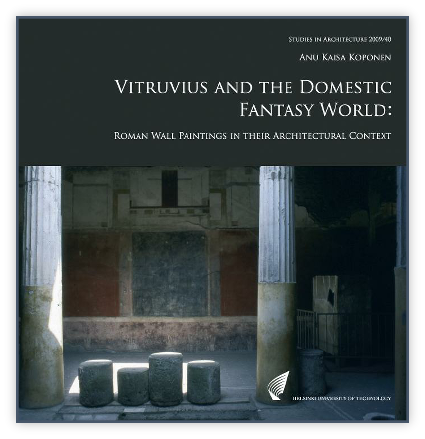Vitruvius and the Domestic Fantasy World: Roman Wall Paintings in their Architectural Context
Anu Kaisa Koponen

Abstract
The doctoral thesis, Vitruvius and the Domestic FantasyWorld: Roman Wall Paintings in their Architectural Context is a survey of the relationship between ancient Roman texts discussing wall paintings and actual visual evidence. In order to avoid the misleading chronological allusions of the four wall painting styles put forward by August Mau in 1882, this study defines diverse groups of wall painting using a division based on various imitations of architectural structures.
The study started in response to the notion that a huge contradiction occurs between ancient Roman textual evidence and the findings: remarks made on wall painting by the ancient authors are surprisingly few, and nearly all of these rare passages are critical of wall painting. Yet, the findings confirm that all Roman houses were richly decorated with wall paintings depicting colourful architectural and decorative elements.
The study suggests that the whole De architectura including the passages on wall painting belonged as a part to the Augustan cultural politics, whereas Roman domestic wall paintings visualize the private interests that contrast the public ideals and lack clear political messages. Vitruvius demands for naturalism, whereas Roman wall paintings are full of fantasy figures. The study suggests that Vitruvius’s condemnation of the current wall painting fashion was aimed at the decorative and religious influence from Egypt, which had been firmly integrated into the Roman culture during the Late Republic.
By analyzing wall paintings in their architectural context and in relation to Vitruvius’s De architectura, this study implies that not only materialistic values but also the private spiritual fantasies and religious interests became visualized in Roman domestic interiors. A fantasy world was created inside the Roman house. It blurred boundaries between the real and the unreal: a real garden was juxtaposed with a painted garden; a real door with a false door; the inhabitants themselves with images of gods. The Roman house expressed a tense network of diverse meanings offering a wide mental axis from the practical and traditional to the exotic and divine.
Koponen, A. K. “Vitruvius and the Domestic Fantasy World: Roman Wall Paintings in their Architectural Context”. Doctoral dissertation, Studies in Architecture 2009/40. Espoo: Helsinki University of Technology. http://www.anukaisakoponen.altervista.org/


